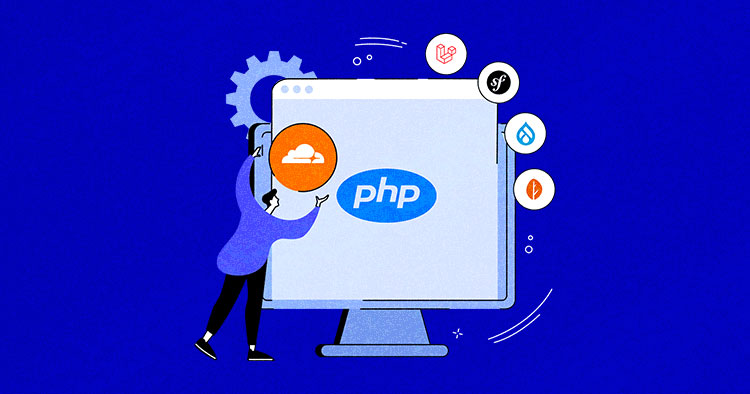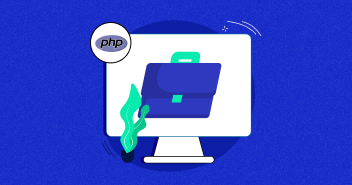
A CDN is a network of computers that delivers the static, streaming and dynamic content of your site, including media files, stylesheets, CSS, and JavaScript files. This content is hosted on a network of servers spread over the world. So when a user sends a request from a browser, that request is handled by the nearest server to avoid latency.
A PHP CDN balances activity so everyone gets the best experience possible. Think of it as directing activity within the real world. There may be one route that’s ordinarily the speediest from point A to point B if no other cars take it. But if it begins to see high traffic, it’s better for everybody if the traffic spreads out over a number of diverse routes.
In this piece, I’ll introduce you to Cloudflare CDN as one of the best options for your PHP website, and show you how to enable it.
How Does a CDN Work?
A CDN delivers content as quickly, dependably, and safely as possible. It will put servers at the exchange focuses between diverse systems to improve speed and network.
Internet exchange points (IXPs) are where Internet providers interface to provide each other access to activity beginning on their distinctive networks. CDNs place servers at these points to reduce costs and transit times in high-speed information delivery.
CDNs also optimize standard client/server data exchanges. They use data centers in vital locations across the globe, improve security, and eliminate blockages in web delivery.
Advanced CDNs regularly offer auto-optimization layers that can resize pictures and save them for future use. So if your website features a 2MB header picture and the user requests it on a 300px wide, the CDN will serve a duplicate that’s 30KB in the estimate and 300px wide. That makes the website faster.
What are Some Different Types of PHP CDNs?
Content-oriented CDNs
These CDNs optimize both static and dynamic content, including JS, CSS and HTML. Numerous CDNs now cache a website’s “last alive” status as well, so if it goes down, the cached content is still open to clients until things go back to normal.
Security-oriented CDNs
Many CDNs offer DDoS and bot security. As the CDN is the peripheral layer of a website’s foundation and the primary recipient of traffic, it can identify DDoS attacks early on and deter them before they ever reach the root server and crash it.
Furthermore, by utilizing knowledge crowdsourced from its numerous clients, a CDN can learn to identify suspicious IPs, spammers, botters, and even types of crawlers and their behavior. For example, a scraper identified on site A will stop working on site B. And if that website is secured by the same CDN, the activity filter will recognize a design it’s seen before.
A Mix of Both
The best of both worlds, these CDNs optimize content for laser-fast delivery, and simultaneously protect your website from DDoS attacks and bots. Cloudflare CDN is one great example of this.
Keep Your Apps Secure on Cloud
Cloudways offers 2FA, free SSL, and more advanced security features on managed servers that keep your application safe.
Who Needs Cloudflare CDN?
Almost all PHP sites need a CDN, which is why there is such exponential growth in the number of sites using one. In particular, if you operate in multiple geographical locations, you’ll need to use a good CDN, like Cloudflare PHP to speed up delivery.
The Cloudflare CDN is perfect for PHP sites in ecommerce, agencies, media and entertainment, streaming, online gaming, education, healthcare, and more.
Here’s a quick rundown of what the Cloudflare CDN can do for you:
- Decrease your page load times with readily available content from the CDN server network
- Handle high traffic without downtime or slow speeds
- Reduces bandwidth consumption
- Secures your site against DDoS attacks and bots
- Enhances user experience on both desktop and mobile devices
How to Enable Cloudflare PHP on Your Website
(4 Steps)
If you have one of our Cloudways managed hosting accounts, you can actually turn on CloudFlare CDN within the Platform. Just follow these easy step-by-step instructions.
Step 01: Select Application
Login to your Cloudways platform, go to Applications and click on the PHP site you want to add the CloudFlare CDN to.
- Click on your server to get into the Application Management dashboard.
- Click www
- Choose your application.

Note: I’ve assumed that you have already connected your domain with the Cloudways Platform using domain management.
Step 02: Configure Cloudflare PHP
Under Application Management, select Cloudflare.

Enter your domain name. Cloudflare Enterprise supports root domains and subdomains. You can enter a root domain (cwdemoapp.com) or a subdomain (support.cwdemoapp.com/).
Next, click Enable.

This will enable the Cloudflare CDN integration for our application, and automatically show you the popup below in TXT Validation. Next, you have to add the TXT Record to your DNS management service.
Step 03: TXT Validation

Confirm space ownership by including one or two TXT records to your DNS registrar panel. The method of including DNS records changes over distinctive DNS managers. I am utilizing Namecheap here.
Visit your DNS registrar panel, select your domain, and add both TXT records in the DNS management section.

Once you have added the DNS records, it may take up to 24 hours for your DNS changes to be implemented. Cloudways will periodically check to confirm the specified DNS records are included so space ownership can be confirmed.
Switch back to the Cloudways Platform, tap Next, and press Finish. The current status may be ‘Pending Verification’, which implies Cloudways is still verifying the ownership of your domain.
The time required to verify ownership is dependent on the DNS propagation.

Step 04: Point To IP
First, copy the A Record (Name/Host and Value) with both IP addresses.

Revisit your DNS registrar panel and add the two A records.
Note: Before adding the A records, remove any existing CNAME and A records for your domain pointing to your Cloudways server IP address to avoid conflicts.

After configuring A records for your root domain, we recommend pointing the www version of your website to Cloudflare Enterprise Network. To do so, simply add or edit a CNAME record for your www domain pointing to your root domain.
Switch back to the Cloudways Platform and click Done.

Once Cloudflare is integrated with your domain, the status will change to ‘Active.’

That’s all! You get a bunch of options after configuring Cloudflare on your PHP site.
Conclusion
The CDN market has exploded since 2020 to give you a plethora of excellent options for content delivery and security. Cloudways has partnered with Cloudflare – the top trusted name in this game – to bring your PHP site excellence. Activate Cloudflare for your website and watch its performance spike to new levels!
Shahzeb Ahmed
Shahzeb is a Digital Marketer with a Software Engineering background, works as a Community Manager — PHP Community at Cloudways. He is growth ambitious and aims to learn & share information about PHP & Laravel Development through practice and experimentation. He loves to travel and explore new ideas whenever he finds time. Get in touch with him at [email protected]


